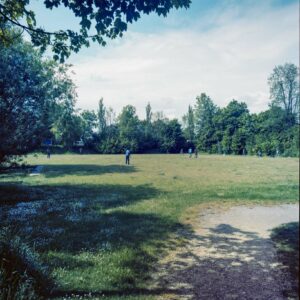MEMORY IN PRACTICE
During World War II there were more than 400 units of collective accommodation for forced laborers in the Munich area alone. In some cases the barracks were erected in the immediate vicinity of places of work or on company premises. In others, schools, gymnasiums, or guesthouses were converted into housing. Today, there are virtually no visible signs of these historic buildings. The photographer Hadas Tapouchi visited 30 of these sites, seeking to make their former presence come alive again. The interactive map of the city invites you to document changes in the urban space yourself and to share them with others, thus forging a connection between physical historical sites and digital memory space.
List of former forced labor camps in Munich
All information are based on the data base of the Munich Documentation Centre for the History of National Socialism.
Fraunbergplatz 9
today Fraunbergstraße 8
Leopoldstraße 175
Ettstraße 2
11 bis 50 Personen
Ingolstädter Straße 193
Fürstenrieder Straße 155 (Kur- und Heilanstalt Neufriedenheim)
From at least 1 December 1944 until the end of the war, 19 Italian workers (released prisoners of war) who worked for the construction and civil engineering company were housed in the building, which belonged to the Reichsleitung der NSDAP.
11 bis 50 Personen
Stadelheimer Straße 10
In November 1942, the State Opera rented the rear building of the house to forced labourers.
Herzog-Rudolf-Straße 1
From 1941 onwards, up to 50 French prisoners of war were housed in the shelter, who were mainly used for work on farms in the surrounding area.
51 bis 100 Personen
Schwemmstraße 6
The work detail of prisoners from Dachau concentration camp existed from June 1942 to July 1944 and was housed in the former Jewish old people’s home in Mathildenstraße. This building had previously been taken over by the “Lebensborn” association founded by the SS. The prisoners were also used for repair and clean-up work in other places in the city. Numerous cases of mistreatment are documented. After the building was destroyed by bombs in July 1944, the Lebensborn headquarters and its prisoners moved to Steinhöring in the district of Ebersberg.
11 bis 50 Personen
Mathildenstraße 9
today Mathildenstraße 1b
The work detail 340 of Stalag VIIa was housed there with French prisoners of war who had to work for the neighbouring (No. 7) Saumweber company.
Emil Geis-Straße 9
Schulstraße 3
51 bis 100 Personen
Arnulfstraße 52
51 bis 100 Personen
Zielstattstraße 37
The camp for “Italian military internees” was occupied by up to 168 people. They had to do work for various companies. They were mainly entrusted with roofing work.
101 bis 500 Personen
Krumbadstraße without a number
today Echardinger Straße 29a
101 bis 500 Personen
Hechtseestraße
The camp was an overnight camp for forced labourers (130 Dutch postal workers in 1941) who were employed by the Reichspost and housed in the attic of the Wredestraße (corner of Arnulfstraße) post office building (“Speiseanstalt”) – later another room in the neighbouring Tillystraße was used as accommodation for Dutch people.
101 bis 500 Personen
Wredestraße 1/3
Keferstraße 8c
today Keferstraße 18
Nägeliplatz
11 bis 50 Personen
Allach, Dietrich-Eckart-Straße 34
today Esmarchstraße 34
501 bis 1000 Personen
Guldeinstraße 27
11 bis 50 Personen
Moosach, Siemensstraße
The camp existed from June 1944 to April 1945. The work detail of about 30 prisoners from Dachau concentration camp was housed in a garage on the company premises and, after it was destroyed in a bombing raid, in a cellar. The prisoners were used for clean-up, repair and relief work.
11 bis 50 Personen
Osterwaldstraße 10
101 bis 500 Personen
Zollstraße 1
today Zollstraße 3
11 bis 50 Personen
Koppstraße 6




































